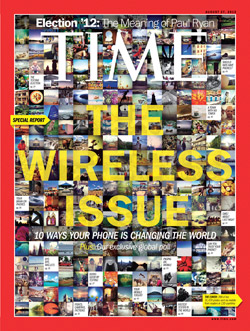 To be fair, Time magazine is available in a digital version on tablet devices and has apps to which it feeds real-time news. And they are not that bad, as magazine
apps go. But the deep irony of seeing its special “Wireless Issue” hit physical newsstands this week is not to be missed. Better still, the cover is composed of 200 Instagram photos culled
from a pile of 31,429 that magazine readers submitted from more than 120 countries. You've got to wonder how many unpaid Ivy League interns it took to rifle through those. But there you go,
Instagram…in print.
To be fair, Time magazine is available in a digital version on tablet devices and has apps to which it feeds real-time news. And they are not that bad, as magazine
apps go. But the deep irony of seeing its special “Wireless Issue” hit physical newsstands this week is not to be missed. Better still, the cover is composed of 200 Instagram photos culled
from a pile of 31,429 that magazine readers submitted from more than 120 countries. You've got to wonder how many unpaid Ivy League interns it took to rifle through those. But there you go,
Instagram…in print.
Oh, I kid because I love. Magazines are in steady decline with their print products. Pivotal Research’s recent revised forecast of ad spend on major media is
showing about 5% declines in ad spending on national magazines for each of the next five years. It will see its slice of the overall ad pie shrink from about 20% or so to just over 13%. Get us more of
those unpaid interns.
advertisement
advertisement
But Time does get the wireless jones, at least as a hot story, by doing extensive surveys of popular attitudes toward their devices. And gee whiz, don’t
they find that this mobile phone stuff really is a big deal. There are the usual attitudinal questions designed to impress us with mobile obsession. To wit: 65% of mobile phone owners say they would
rather take their phone with them out the door than lunch. Half of us in the U.S. sleep with the phone next to our bed. Almost a third say they would rather communicate via text message.
And
then, of course, there is the sex issue. Almost a quarter worldwide admit to using SMS “to coordinate or commit adultery.” “Commit adultery?” Well, I am not sure how they are
doing it, but apparently they are doing it a lot more overseas than here. In the feature story this week, Time states that less than 10% of Americans use SMS to arrange for (or commit right
then and there on their damned phone!) adulterous activity. But more than half of Chinese users say they do.
And Rep. Anthony Weiner was not a rarity. They also find that a quarter of all
Americans and more than half of men ages 18 to 35 have used their phones to send provocative pictures of themselves.
Give Time their props. While I have only seen the table of
contents and lead piece thus far, it does look as if they devoted the entire issue to mobile matter. In fact, one of our speakers at next week’s Mobile Insider Summit, Jed Alpert of
MobileCommons, is featured in a piece. They field test a mobile wallet, explore the impact of mobile on campaign messaging and donations, and naturally address the issue of data collection.
I
don’t see a piece on how the emergence of handy and engaging touchscreens is accelerating the decline of print media, however.
Where will all those interns go?